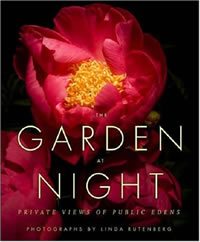 As a resident of Montreal, Linda Rutenberg does not qualify as a Pacific Northwest author, but the collection of her photographs in the 2007 publication “The Garden at Night: Private Views of Public Eden” includes PNW subjects. The Washington Park Arboretum and the Butchart Gardens are both featured, as are several other west coast gardens. The Italian Garden at Butchart is particularly enchanting at night, and one simply must experience Azalea Way — after dark!
As a resident of Montreal, Linda Rutenberg does not qualify as a Pacific Northwest author, but the collection of her photographs in the 2007 publication “The Garden at Night: Private Views of Public Eden” includes PNW subjects. The Washington Park Arboretum and the Butchart Gardens are both featured, as are several other west coast gardens. The Italian Garden at Butchart is particularly enchanting at night, and one simply must experience Azalea Way — after dark!
Excerpted from the Fall 2009 Arboretum Bulletin.
 “The Northwest Green Home Primer” is a helpful book for planning your garden. While the emphasis is on the home, a chapter entitled “Site Choices” has good advice for the surrounding landscaping, especially how and where to plant trees, and briefly addresses other green practices such as rain gardens to maximize the use of runoff.
“The Northwest Green Home Primer” is a helpful book for planning your garden. While the emphasis is on the home, a chapter entitled “Site Choices” has good advice for the surrounding landscaping, especially how and where to plant trees, and briefly addresses other green practices such as rain gardens to maximize the use of runoff.
Excerpted from the Fall 2009 Arboretum Bulletin.
 Briefly, gardeners should read “The Weather of the Pacific Northwest” by Cliff Mass, as the local weather is our constant companion. While this doesn’t specifically address the concerns of gardeners, it will help you make sense of forecasts and appreciate the unpredictability of our weather.
Briefly, gardeners should read “The Weather of the Pacific Northwest” by Cliff Mass, as the local weather is our constant companion. While this doesn’t specifically address the concerns of gardeners, it will help you make sense of forecasts and appreciate the unpredictability of our weather.
Excerpted from the Fall 2009 Arboretum Bulletin.
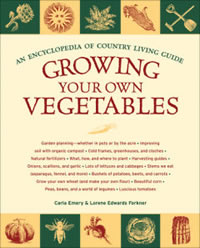 Lorene Edwards Forkner tackled a huge task. She took the 900 plus pages of the late Carla Emery’s “The Encyclopedia of Country Living” and distilled out of this sometimes wandering magnum opus (in 10 editions over 35 years) the essentials of vegetable gardening.
Lorene Edwards Forkner tackled a huge task. She took the 900 plus pages of the late Carla Emery’s “The Encyclopedia of Country Living” and distilled out of this sometimes wandering magnum opus (in 10 editions over 35 years) the essentials of vegetable gardening.
The resulting “Growing Your Own Vegetables” is a well organized and very readable work (at a comparatively slim 179 pages) that still captures the enthusiasm and down-to-earth charm of the original. While the authors both have Pacific Northwest roots, this book is written for a general audience, and so the section on okra is best skipped in planning your Seattle P-patch.
That said, there are still lots of useful and practical cultural tips. But I found it most charming in the somewhat quirky side boxes, such as that on Draft Horses and Power Tools: “Pat the animal and let it know you appreciate it after a good hard pull.”
Excerpted from the Fall 2009 Arboretum Bulletin.
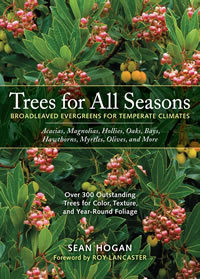 Portlander nurseryman Sean Hogan addresses a neglected part of the garden palette in “Trees for All Seasons: Broadleaved Evergreens for Temperate Climates”. And he does it with great enthusiasm; being quite candid that one of his goals is increased planting of these excellent but underused plants.
Portlander nurseryman Sean Hogan addresses a neglected part of the garden palette in “Trees for All Seasons: Broadleaved Evergreens for Temperate Climates”. And he does it with great enthusiasm; being quite candid that one of his goals is increased planting of these excellent but underused plants.
First, he defines his scope. Conifers, or monocots such as palms, are not included. He’s also strict about evergreen, subjects must “…keep their leaves year-round, or nearly so, but also remain attractive while doing so.” Icons with each entry give size and shape, and emphasize these are trees, not shrubs (he’s saving those for his next book).
The typical A-Z encyclopedia — with some bunching of closely related genera — is written for horticulturists (not botanists!) in temperate zones, and gives considerable gradation to the cold-hardiness and other exacting, cultural needs. For example, I learned that a favorite tree of mine from trips to the southwest, the Texas mountain laurel (Sophora secundiflora) would “…experience imperceptibly slow growth, or even lose ground…” in my Seattle garden without heroic efforts to match its preferred “swamp-cooler” climate.
Always the nurseryman, Hogan gives detailed notes about propagation and the habits of young nursery stock, always written in an easy to understand manner. Need to propagate your olive? Historically this was done by “chopping the heavily burled bases into pieces, pulling chunks out of the ground, then dragging them to the next area where, eventually, an olive tree would grow.” He goes on to say that with less effort similar results can be obtained from well-ripened cuttings with a high…ish level of hormone…along with a steep wound.”
This book will certainly enhance your appreciation of the Arboretum’s collection of broadleaved evergreens.
Excerpted from the Fall 2009 Arboretum Bulletin.
 John Charles Olmsted made numerous visits to the Pacific Northwest from 1903-1911. This nephew of Frederick Law Olmsted was himself a highly regarded landscape architect and noted for his attention to fine detail. The chronicle of his many projects in the region is written with this same, careful attention to detail by Joan Hockaday in “Greenscapes: Olmsted’s Pacific Northwest.”
John Charles Olmsted made numerous visits to the Pacific Northwest from 1903-1911. This nephew of Frederick Law Olmsted was himself a highly regarded landscape architect and noted for his attention to fine detail. The chronicle of his many projects in the region is written with this same, careful attention to detail by Joan Hockaday in “Greenscapes: Olmsted’s Pacific Northwest.”
Olmsted was a prolific writer, both in his professional records and in his correspondence (5,000 private letters survive), especially his daily letters to his wife Sophia and their daughters at home in Brookline, Massachusetts. Hockaday uses this wealth of sources to create a book that works on several levels: as a history of a important time in the development of our region, as a biography of a skilled landscape architect working in the shadow of his more famous uncle, and as a glimpse of a by-gone era through garden design.
While his work took him from Vancouver Island to the University of Idaho and south to Corvallis, much the book’s focus is on Seattle, where he spent some 300 days during those nine years. Hockaday convincingly argues that Olmsted is responsible for much of what now defines the city, especially with the park system, Lake Washington Boulevard, the University of Washington campus (including Rainier Vista), and many private residences.
Excerpted from the Fall 2009 Arboretum Bulletin.
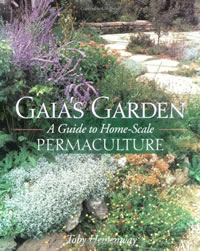 Start healing the planet right in your own backyard! Learn about the principles of ecological garden design, water conservation strategies and supporting wildlife from Toby Hemenway, author of Gaia’s Garden: A Guide to Home-Scale Permaculture. Inspiring anecdotes make this book fun to read, while practical advice, illustrated examples and long lists of useful plants help gardeners start transforming their backyards right away.
Start healing the planet right in your own backyard! Learn about the principles of ecological garden design, water conservation strategies and supporting wildlife from Toby Hemenway, author of Gaia’s Garden: A Guide to Home-Scale Permaculture. Inspiring anecdotes make this book fun to read, while practical advice, illustrated examples and long lists of useful plants help gardeners start transforming their backyards right away.
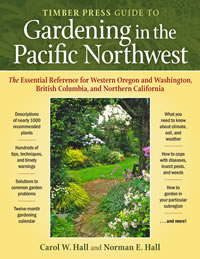 When authors Carol and Norman Hall started gardening in the Pacific Northwest in the 1970’s they had to learn to grow their plants by trial and error, because most gardening books of the time addressed only East Coast weather conditions, such as summer rain and winter freezing.
When authors Carol and Norman Hall started gardening in the Pacific Northwest in the 1970’s they had to learn to grow their plants by trial and error, because most gardening books of the time addressed only East Coast weather conditions, such as summer rain and winter freezing.
However, perhaps it’s just as well the authors had to figure it out on their own because their depth of understanding how the Pacific Northwest climate affects plants is impressive. Although the question of where the boundaries of the Pacific Northwest lie is open to debate, the Halls define them as: the areas stretching between the ocean coast and the Cascade Range, and between latitude 51° in British Columbia and latitude 41° in northern California. The northern boundary was chosen because north of latitude 51° the “difference between high and low temperatures become smaller and light intensity starts to diminish even on clear days… gardening conditions beyond this point are not those of the Pacific Northwest, but those of coastal Alaska.” The southern border seems a bit more arbitrary, especially on the coast, but the authors note: “It’s only after negotiating the steep descent from [the Cascade Range] to the valley floor and seeing the palm trees lining the streets of Redding, California, that you know you’ve suddenly entered a whole new gardening world.” The unifying climatic conditions that defines the region are wet, mild winters and dry summers.
This large format book with 351 pages and a liberal use of color photographs is divided into 4 sections: the region, 12 month maintenance calendar, recommended plants and common problem & solutions.
Detailed descriptions of climate, soils and horticultural conditions are given about the region’s seven sub-regions, which include: the Georgia Basin/Puget Trough, the Olympic Rain Shadow, Puget Sound, Pacific Coast (northern section), Pacific Coast (southern section), the Cascade Slopes/Outflow Valleys and Willamette. The authors recommend their favorite plants that grow well in the Pacific Northwest according to plant types such as: ornamental trees, shrubs, bulbs, and others. Instructions on caring for the recommended plants always refer to specific Pacific Northwest climate considerations. For example, heaths and heathers need supplemental water during our typical regional summer droughts for the first two years, until they become established.
This is an excellent general gardening reference that focuses on the Pacific Northwest climate like no other.
Excerpted from the Winter 2009 Arboretum Bulletin.
 Though I will probably never survey my surroundings from the top of a tall beech tree, or climb a frozen waterfall in the dark, I thoroughly enjoyed discovering unspoiled natural areas of Britain through Robert Macfarlane’s book The Wild Places (Granta Books, 2007).
Though I will probably never survey my surroundings from the top of a tall beech tree, or climb a frozen waterfall in the dark, I thoroughly enjoyed discovering unspoiled natural areas of Britain through Robert Macfarlane’s book The Wild Places (Granta Books, 2007).
In richly descriptive prose, he leads the reader to these increasingly rare spots on the map, from saltmarshes and moors to hedgerows and holloways (tunnels of vegetation). Under the tutelage of his friend Roger Deakin (author of Wildwood, who died in 2007), Macfarlane’s conception of wildness evolves over the course of his travels to include the humbler, smaller wild places that are within reach of even the most city-bound nature lovers:
“I thought about how the vision of wildness with which I had begun my journeys – inhuman, northern, remote – was starting to crumble from contact with the ground itself… The human and the wild cannot be partitioned. Everywhere that day I had encountered blendings and mixings.”
 For gardeners, the most important new book of the year will be the “Encyclopedia of Northwest Native Plants for Gardens and Landscapes”. A trio of southwest Washington writers brings extensive experience in botany, propagating and growing native plants, and photography together in this very comprehensive and extensive book that will be a standard reference for many years to come.
For gardeners, the most important new book of the year will be the “Encyclopedia of Northwest Native Plants for Gardens and Landscapes”. A trio of southwest Washington writers brings extensive experience in botany, propagating and growing native plants, and photography together in this very comprehensive and extensive book that will be a standard reference for many years to come.
A brief introduction lays the ground rules: only natives — nothing naturalized since the arrival of “non-indigenous human explorers”. Plants that are rare and nearly impossible to grow in cultivation are out, too. An example being the various lovely but sensitive slipper orchids.
There are some seeming exceptions to this last rule, such as Erythronium montanum, the stunning but notoriously difficult-to-cultivate avalanche lily seen at Hurricane Ridge. However, the authors note, it can be grown by gardeners who live at higher elevations.
The heart of the book is a listing of over 500 species that gives a basic description, cultivation requirements, native range and habitat, plus notes about related species, ethnobotany and selected varieties. Propagation tips are included, with a strong emphasis on conservation of plants in situ.
The excellent photographs make this a pretty good identification book, too, and will convince you to add more natives to your home garden, including ferns, shrubs, and trees, both broad leaf and conifers. The appendices include helpful lists of plants to meet various gardening needs (for shade, for wildflower meadows, for hummingbirds, etc.). This book is a must have!
Excerpted from the Fall 2008 Arboretum Bulletin.
 As a resident of Montreal, Linda Rutenberg does not qualify as a Pacific Northwest author, but the collection of her photographs in the 2007 publication “The Garden at Night: Private Views of Public Eden” includes PNW subjects. The Washington Park Arboretum and the Butchart Gardens are both featured, as are several other west coast gardens. The Italian Garden at Butchart is particularly enchanting at night, and one simply must experience Azalea Way — after dark!
As a resident of Montreal, Linda Rutenberg does not qualify as a Pacific Northwest author, but the collection of her photographs in the 2007 publication “The Garden at Night: Private Views of Public Eden” includes PNW subjects. The Washington Park Arboretum and the Butchart Gardens are both featured, as are several other west coast gardens. The Italian Garden at Butchart is particularly enchanting at night, and one simply must experience Azalea Way — after dark! “The Northwest Green Home Primer” is a helpful book for planning your garden. While the emphasis is on the home, a chapter entitled “Site Choices” has good advice for the surrounding landscaping, especially how and where to plant trees, and briefly addresses other green practices such as rain gardens to maximize the use of runoff.
“The Northwest Green Home Primer” is a helpful book for planning your garden. While the emphasis is on the home, a chapter entitled “Site Choices” has good advice for the surrounding landscaping, especially how and where to plant trees, and briefly addresses other green practices such as rain gardens to maximize the use of runoff. Briefly, gardeners should read “The Weather of the Pacific Northwest” by Cliff Mass, as the local weather is our constant companion. While this doesn’t specifically address the concerns of gardeners, it will help you make sense of forecasts and appreciate the unpredictability of our weather.
Briefly, gardeners should read “The Weather of the Pacific Northwest” by Cliff Mass, as the local weather is our constant companion. While this doesn’t specifically address the concerns of gardeners, it will help you make sense of forecasts and appreciate the unpredictability of our weather. Lorene Edwards Forkner tackled a huge task. She took the 900 plus pages of the late Carla Emery’s “The Encyclopedia of Country Living” and distilled out of this sometimes wandering magnum opus (in 10 editions over 35 years) the essentials of vegetable gardening.
Lorene Edwards Forkner tackled a huge task. She took the 900 plus pages of the late Carla Emery’s “The Encyclopedia of Country Living” and distilled out of this sometimes wandering magnum opus (in 10 editions over 35 years) the essentials of vegetable gardening. Portlander nurseryman Sean Hogan addresses a neglected part of the garden palette in “Trees for All Seasons: Broadleaved Evergreens for Temperate Climates”. And he does it with great enthusiasm; being quite candid that one of his goals is increased planting of these excellent but underused plants.
Portlander nurseryman Sean Hogan addresses a neglected part of the garden palette in “Trees for All Seasons: Broadleaved Evergreens for Temperate Climates”. And he does it with great enthusiasm; being quite candid that one of his goals is increased planting of these excellent but underused plants. John Charles Olmsted made numerous visits to the Pacific Northwest from 1903-1911. This nephew of Frederick Law Olmsted was himself a highly regarded landscape architect and noted for his attention to fine detail. The chronicle of his many projects in the region is written with this same, careful attention to detail by Joan Hockaday in “Greenscapes: Olmsted’s Pacific Northwest.”
John Charles Olmsted made numerous visits to the Pacific Northwest from 1903-1911. This nephew of Frederick Law Olmsted was himself a highly regarded landscape architect and noted for his attention to fine detail. The chronicle of his many projects in the region is written with this same, careful attention to detail by Joan Hockaday in “Greenscapes: Olmsted’s Pacific Northwest.” Start healing the planet right in your own backyard! Learn about the principles of ecological garden design, water conservation strategies and supporting wildlife from Toby Hemenway, author of Gaia’s Garden: A Guide to Home-Scale Permaculture. Inspiring anecdotes make this book fun to read, while practical advice, illustrated examples and long lists of useful plants help gardeners start transforming their backyards right away.
Start healing the planet right in your own backyard! Learn about the principles of ecological garden design, water conservation strategies and supporting wildlife from Toby Hemenway, author of Gaia’s Garden: A Guide to Home-Scale Permaculture. Inspiring anecdotes make this book fun to read, while practical advice, illustrated examples and long lists of useful plants help gardeners start transforming their backyards right away. When authors Carol and Norman Hall started gardening in the Pacific Northwest in the 1970’s they had to learn to grow their plants by trial and error, because most gardening books of the time addressed only East Coast weather conditions, such as summer rain and winter freezing.
When authors Carol and Norman Hall started gardening in the Pacific Northwest in the 1970’s they had to learn to grow their plants by trial and error, because most gardening books of the time addressed only East Coast weather conditions, such as summer rain and winter freezing. Though I will probably never survey my surroundings from the top of a tall beech tree, or climb a frozen waterfall in the dark, I thoroughly enjoyed discovering unspoiled natural areas of Britain through Robert Macfarlane’s book
Though I will probably never survey my surroundings from the top of a tall beech tree, or climb a frozen waterfall in the dark, I thoroughly enjoyed discovering unspoiled natural areas of Britain through Robert Macfarlane’s book  For gardeners, the most important new book of the year will be the
For gardeners, the most important new book of the year will be the